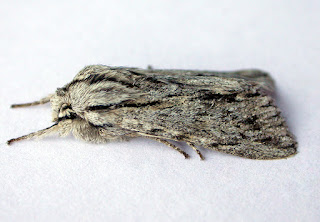Things keep ticking over in the garden here. On the 21st there was just a single Red-green Carpet to the overnight actinic light, the closest I've come yet to having a blank night this winter, but otherwise there has always been a selection of the few species which are still around locally at this time of year (for example, seven moths of five species last night, all macros). Recorded over the past week have been Zelleria hepariella, Emmelina monodactyla, December Moth, Red-green Carpet, Winter Moth, Feathered Thorn, Scarce Umber, Mottled Umber, Sprawler, Brick & Silver Y.
 |
| Zelleria hepariella, Westcott 23rd November |
 |
| Sprawler, Westcott 24th November |
 |
| Silver Y, Westcott 25th November |
Zelleria hepariella is one of the handful of lepidoptera species which use ash as their sole larval food-plant. It still seems to be doing reasonably well despite the fungal disease Hymenoscyphus fraxineus (Ash Die-back) which is causing the demise of many trees locally. Although never common, it is a moth that can usually be relied upon to put in a single garden appearance here each year. This example was actually the third for 2022 and I've had it to light at four other sites in the county too.
Brick (one here on the 25th) seems to be the longest-lived of the autumnal species and records of very faded examples in mid-December are nothing unusual nowadays. However, it is getting a bit late now for Sprawler, of which there were two in the garden on the 24th. In past years it has occasionally lingered on until the end of this month but I have never yet had a December record. The December Moth count is now up to 24 for the year, even though we haven't got to December yet, and amongst them have been five females so far.
Dave Wilton Westcott, Bucks

Hello Dave. I get very few Sprawler here in Newton Longville: just 4 in 2020 (the latest on 8th November) and none at all last year. I've had another four this year, of which the latest (so far?) was on 25th.
ReplyDeleteDecember Moths might be peaking earlier than last year: my peak in 2021 was not until 12th December (12 individuals), but I found 11 earlier this week (on 25th). I find that this is a species for which most individuals are found outside the trap rather than in it: only 2 of the eleven were in the trap on 25th and the other nine were mostly on the sheet hanging behind it, or on the outside of the trap, or on an adjacent tree-trunk.
I was relatively pleased to get nine species on 18th and six species on 25th; last year I was only getting two or three species a night after the middle of the month and it was a similar result in 2019 and 2020.
Here in east Mendip ash dieback is as bad as anywhere in the country, and it's having a serious effect on woodlands - landowners are cutting HS2-style swathes through the woods where footpaths exist, to avoid getting sued when branches fall, and within a few years the cleared ground is turning into impenetrable bramble thickets. Curiously the ash-feeding macros - Centre-barred Sallow, Dusky Thorn - have responded with an increase in numbers, at least for now. Perhaps the disease is letting increased levels of light into the canopy and this is suiting them.
ReplyDelete